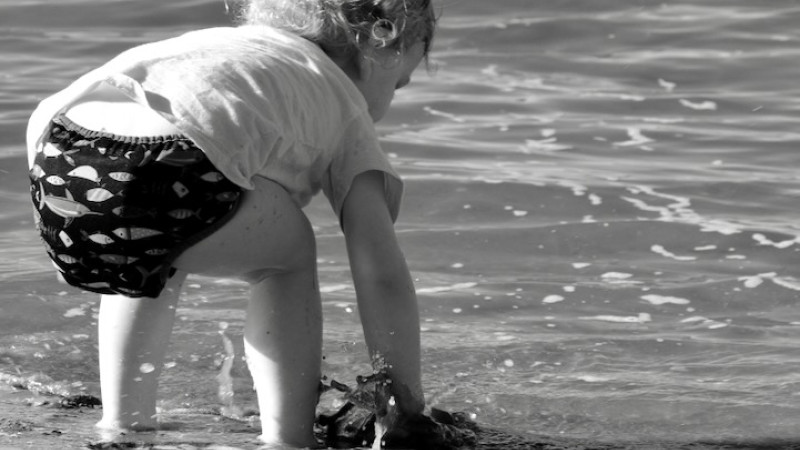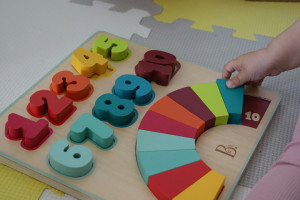Help My Cloth Diapers Leak

Cloth diapers are known to contain blowouts much better than disposable diapers. But like all diapers, cloth diapers can leak as the baby consumes more and grows, and output increases. Leaking diapers can be caused by a few things, but it is usually always the same few things. And most of the time they are preventable with small fixes or adjustments.
When helping cloth diapering families figure out the source of leaking diapers, I always ask the same questions.
How frequently do you change diapers?
What kind of diapers do you use?
How old is your child?
Where does the diaper leak?
Do all/most diapers leak or only a certain type/brand?
Do you use any diaper creams or ointments?
What detergent do you use?
Do you use fabric softener or dryer sheets? On diapers or other laundry?
The most frequent causes of leaking diapers are
Fit is Not Good Enough
It is very important that the diapers fit snugly around the legs but they can not be too tight around baby's belly. That can cause leaks, and can also be uncomfortable for the child. Especially when they are held upright or when they are learning to sit. It is a good rule of thumb is to make sure you can fit two fingers in the waistband when putting the diaper on. Legs should be tight enough so there are no gaps, but not tight enough to cause deep red marks. Sock marks after the elastics around the legs are fine, as long as they are not red, angry, or last long. Marks around the legs that last long could be associated with detergent buildup, ammonia burn or elastic sensitivity.
Not Frequent Enough Diaper Changes
Diapers should be changed or checked regularly, max every two hours. The two hour mark is even the standard with disposable diapers. If the diaper is dry, we would recommend that you check again in a few minutes, max every 15 minutes until the diaper is wet or soiled. With newborns, we would recommend changing diapers more frequently if possible, checking every hour or more. Newborns pee and poop so frequently. Breastfed babies particularly, as human milk is quickly and easily digested, so nursing and wetting the diaper frequently is very normal.
Not Enough Absorbency
It is a fact that babies and toddlers pee a lot, especially when considering most of their diet is liquid. How do you know if lack of absorbency is the cause of the leaks? If you are changing the child max every two hours and the insert is dripping or fully soaked when you take the diaper off, you need more absorbency. Adding a cotton or hemp booster often does the trick. As the child ages, they often pee less frequently but pee more each time, often flooding the diaper.
After a year old, when toddlers start drinking more water with their meals they often pee less frequently but pee more each time, flooding the diaper. If newborn is wearing a microfiber aio, often adding a cotton washcloth/wipe in the diaper can boost absorbency and help the diaper last a little longer without leaking.
If the baby is very young we would recommend changing the diaper more frequently if possible, before considering upping the absorbency. Newborns have really delicate skin and they are known to pee as often as every 15 minutes.
Compression Leaks From Microfiber
Microfiber is notorious for causing compression leaks. Microfiber works like a sponge, it absorbs fast, but the smallest compression causes the diaper to leak. Think, squeezing a sponge full of water. Here adding cotton or hemp boosters/inserts could help absorb the excess and prevent the moisture from leaking out of the diaper.
If this happens every diaper change, we would recommend changing the microfiber out for a natural fiber absorbency.
Tight Clothes Wicking Moisture Out of the Diaper
Tight clothes that dig into the underwear line (groin) can wick out the moisture by the leg elastics. This is quite common with onesies and leggings. To prevent wicking size up in pants or skip snapping the onesie or only snapping the middle one can help keep the fabric away.
Flooding
As the child ages they get more aware and start holding it for longer. Consequently they are peeing less frequently and more each time. Often they pee so fast that the absorbency doesn’t manage to catch all and wick to the other layers, before the diaper starts to leak. Adding a fast absorber like cotton booster, cotton wipe or even microfiber right in the wet one can help combat that. Remember microfiber can not go against the skin, and needs to be covered with another skin friendly layer.
Bad pul/tpu
Bad PUL or TPU is not very common, but it does happen. Quality diapers are made to last, to diaper at least one if not two children. So they should tolerate being washed and reused. But sometimes a bad batch of PUL, makes the PUL delaminate quickly or they get snagged by something in the washer etc. If the diaper leaks around the rise snaps, the PUL might have a hole. With covers and pocket diapers it is easy to inspect the PUL to see if it is defective.
Some brands recommend that you put the diaper in the dryer for a few minutes once in a while to reseal the fabric, while other brands are made differently and advise against using the dryer. Look up your diaper manufacturer's recommendation if it is not clearly labeled on the diaper.
If the hole is little, sometimes changing the diaper a little more frequently or adding a little absorbency can prevent the diaper from leaking.
Repelling
Repelling can occur If the wrong detergent or ointment is used with the diapers. Synthetic fibers are more prone to repelling than natural fibers. Repelling can be caused by fabric softeners, detergent with fabric softeners or dryer sheets. This prevents the diaper from effectively absorbing and therefore reduces its performance. When shopping for detergent it is good to stay away from detergents with fabric softeners added. Some diaper creams or ointments can also coat the fibers and make them repel water instead of absorbing. Creams that have petroleum jelly (also known as petrolatum, vaselin) are known to cause this issue. Synthetic fibers, like fleece, athletic wicking jersey and suede cloth seem to be more affected. If diapering with natural fibers, and washing with hot water and a good mainstream detergent you usually don’t have to worry about this. If you have issues with repelling, a good start would be stripping and sanitizing the diapers and then start over with a good detergent and a cloth safe ointment.




